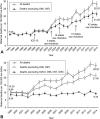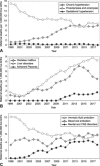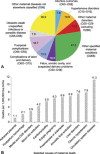Maternal Mortality in the United States: Recent Trends, Current Status, and Future Considerations
- PMID: 33831914
- PMCID: PMC8055191
- DOI: 10.1097/AOG.0000000000004361
Maternal Mortality in the United States: Recent Trends, Current Status, and Future Considerations
Abstract
Rigorous studies carried out by the National Center for Health Statistics show that previously reported increases in maternal mortality rates in the United States were an artifact of changes in surveillance. The pregnancy checkbox, introduced in the revised 2003 death certificate and implemented by the states in a staggered manner, resulted in increased identification of maternal deaths and in reported maternal mortality rates. This Commentary summarizes the findings of the National Center for Health Statistics reports, describes temporal trends and the current status of maternal mortality in the United States, and discusses future concerns. Although the National Center for Health Statistics studies, based on recoding of death certificate information (after excluding information from the pregnancy checkbox), showed that crude maternal mortality rates did not change significantly between 2002 and 2018, age-adjusted analyses show a temporal reduction in the maternal mortality rate (21% decline, 95% CI 13-28). Specific causes of maternal death, which were not affected by the pregnancy checkbox, such as preeclampsia, showed substantial temporal declines. However, large racial disparities continue to exist: Non-Hispanic Black women had a 2.5-fold higher maternal mortality rate compared with non-Hispanic White women in 2018. This overview of maternal mortality underscores the need for better surveillance and more accurate identification of maternal deaths, improved clinical care, and expanded public health initiatives to address social determinants of health. Challenges with ascertaining maternal deaths notwithstanding, several causes of maternal death (unaffected by surveillance artifacts) show significant temporal declines, even though there remains substantial scope for preventing avoidable maternal death and reducing disparities.
Copyright © 2021 The Author(s). Published by Wolters Kluwer Health, Inc.
Conflict of interest statement
Financial Disclosure The authors did not report any potential conflicts of interest.
Figures




Comment in
-
The Continuing Challenge of Measuring Maternal Mortality.Obstet Gynecol. 2021 May 1;137(5):761-762. doi: 10.1097/AOG.0000000000004365. Obstet Gynecol. 2021. PMID: 33831926 No abstract available.
References
-
- WHO, UNICEF, UNFPA, The World Bank and the United Nations Population Division. Trends in maternal mortality: 1990 to 2013. Estimates by WHO, UNICEF, UNFPA, The World Bank and the United Nations Population Division. Geneva: Accessed November 1, 2020. http://www.who.int/reproductivehealth/publications/monitoring/maternal-m...
-
- WHO, UNICEF, UNFPA, World Bank Group and the United Nations Population Division. Trends in maternal mortality: 1990 to 2015. Estimates by WHO, UNICEF, UNFPA, World Bank Group and the United Nations Population Division. Accessed November 1, 2020. http://www.who.int/reproductivehealth/publications/monitoring/maternal-m...
-
- WHO, UNICEF, UNFPA, World Bank Group and the United Nations Population Division. Maternal mortality: levels and trends, 2000 to 2017. Accessed November 1, 2020. https://www.who.int/reproductivehealth/publications/maternal-mortality-2...
-
- Kassebaum NJ, Bertozzi-Villa A, Coggeshall MS, Shackelford KA, Steiner C, Heuton KR, et al. . Global, regional, and national levels and causes of maternal mortality during 1990-2013: a systematic analysis for the Global Burden of Disease Study 2013. Lancet 2014;384:980–1004. doi: 10.1016/S0140-6736(14)60696-6 - DOI - PMC - PubMed
Publication types
MeSH terms
LinkOut - more resources
Full Text Sources
Other Literature Sources
Medical

